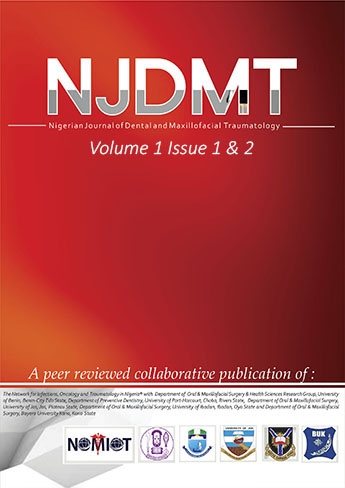Computed Tomographic Evaluation of Facial Fractures in Head Injured Patients following Motorcycle Accidents seen in a Nigerian Tertiary Hospital
Main Article Content
Abstract
Aim: This study aims to determine the prevalence and nature of facial fracture associated with head injury as seen in motorcycle accident using a cranial CT scan. Patients and Methods: This was prospective study carried out at the University of Benin Teaching Hospital on patients who were involved in motorbike accident with history of head injury and associated injury to the face necessitating a cranial Computed Tomographic scan. Results: A total of one hundred and six patients made up of 99 (93.4%) males and 7 (6.6%) females were recruited. The male to female ratio was 14:1. The mean age of the study population was 36.3 years ± 1.33 years (range18 years to 80 years). Majority (36.8%) of the patients were within the 20-29 years range followed by age group 30-39 years (22.6%). Seventy-three (73.7%) of the ninety-nine male patients were motorbike riders while 6 (85.7%) of the 7 female patients were passengers. Sixty cases had facial fractures associated with head injury representing a prevalence rate of 56.6%. Fracture of the upper third of the face - frontal bone n = 36 (57.1%) was the commonest finding on the CT scan. Eighty-one (76.4%) patients had evidence of one or more types of intracranial hemorrhage. Forty-four patients had both facial fracture and some forms of intracranial haemorrhage. Intracerebral haemorrhage 35 (58.3%) was the commonest form of intracranial haemorrhage. Conclusion: There is a high prevalence of facial fractures associated with head injury in motorcycle accident victims. Males in the third decade of life are mostly affected. There is an urgent need for the regulatory bodies to enforce the existing traffic codes and engage in public enlightenment programs on the consequences of non-adherence to traffic rules.

